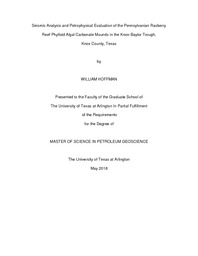
ATTENTION: The works hosted here are being migrated to a new repository that will consolidate resources, improve discoverability, and better show UTA's research impact on the global community. We will update authors as the migration progresses. Please see MavMatrix for more information.
Show simple item record
| dc.creator | Hoffman, William | |
| dc.date.accessioned | 2018-06-05T16:21:03Z | |
| dc.date.available | 2018-06-05T16:21:03Z | |
| dc.date.created | 2018-05 | |
| dc.date.issued | 2018-02-27 | |
| dc.date.submitted | May 2018 | |
| dc.identifier.uri | | |
| dc.identifier.uri | http://hdl.handle.net/10106/27370 | |
| dc.description.abstract | The Ellis Ranch Wildcat field in Knox County, Texas produces from an isolated carbonate platform located on the northern flank of the Knox-Baylor Trough. The platform is composed of the Desmoinesian aged Caddo Limestone and Rasberry Reef. The Rasberry Reef contains aragonitic, phylloid algal bafflestone mounds that form excellent hydrocarbon reservoirs. Aragonitic grains are prone to dissolution during burial and generate vuggy, intragranular porosity that enhances reservoir quality and connectivity. Similarly aged Caddo mounds have been drilled in Stephens County just southeast and on the opposite flank of the Knox-Baylor Trough.
A forty-five foot core section was cut from the Rasberry Reef and tested for porosity, permeability and saturation content by Core Labs. Core-derived porosity ranges from 0.5% to 9.45% and bulk volume hydrocarbons ranges from 1.35% to 3.39%. Log-derived values derived using the Archie water saturation equation and rock-fluid model are compared with core-derived values to identify and understand any discrepancies between the data sets.
Petrophysical logs are used to generate a rock-fluid model for the wells that displays their total porosity and rock matrix composition. The rock matrix model is built using photoelectric, bulk density and neutron-density porosity logs. Total porosity is represented as the sum of the bulk volume hydrocarbons, bulk volume water and clay bound water.
Seismic analysis used in conjunction with the material above provides the geologist with an understanding of the type of deposit and structure of the carbonate buildup, reservoir, and shelf margin. Once the structure is identified in cross section, instantaneous frequency attribute mapping is used to identify the lateral extent of porous reservoirs. Instantaneous frequency mapping identified several deltas deposited over different time periods that prograded over the surrounding reefs. The discoveries led to a new drilling program targeting a shelf edge reef and further evaluation of the carbonaceous deltas. | |
| dc.format.mimetype | application/pdf | |
| dc.language.iso | en_US | |
| dc.subject | Phylloid algal mounds | |
| dc.subject | Petrophysical evaluation | |
| dc.subject | Seismic analysis | |
| dc.title | Seismic Analysis and Petrophysical Evaluation of the Pennsylvanian Rasberry Reef Phylloid Algal Carbonate Mounds in the Knox-Baylor Trough, Knox County, Texas | |
| dc.type | Thesis | |
| dc.degree.department | Earth and Environmental Sciences | |
| dc.degree.name | Master of Science in Earth and Environmental Science | |
| dc.date.updated | 2018-06-05T16:22:06Z | |
| thesis.degree.department | Earth and Environmental Sciences | |
| thesis.degree.grantor | The University of Texas at Arlington | |
| thesis.degree.level | Masters | |
| thesis.degree.name | Master of Science in Earth and Environmental Science | |
| dc.type.material | text | |
Files in this item
- Name:
- HOFFMAN-THESIS-2018.pdf
- Size:
- 8.421Mb
- Format:
- PDF
This item appears in the following Collection(s)
Show simple item record


